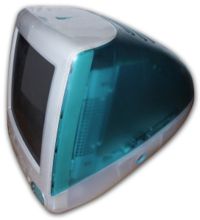All-in-One PC: Difference between revisions
imported>Derek W Anderson No edit summary |
imported>Derek W Anderson No edit summary |
||
| Line 1: | Line 1: | ||
[[Image:IMac Bondi Blue.jpg|thumb|right|200px| The original [[iMac]], an example of a modern-day AIO. Unlike many previous AIOs, the iMac featured built-in speakers and a unique "egg-shaped" case.]] | [[Image:IMac Bondi Blue.jpg|thumb|right|200px| The original [[iMac]], an example of a modern-day AIO. Unlike many previous AIOs, the iMac featured built-in speakers and a unique "egg-shaped" case.]] | ||
An '''All-in-One computer''' (or '''AIO''') is a [[personal computer]] that combines the [[tower case]] of the computer with the [[computer monitor|monitor]] to create a single unit. Many | An '''All-in-One computer''' (or '''AIO''') is a [[personal computer]] that combines the [[tower case]] of the computer with the [[computer monitor|monitor]] to create a single unit. Many personal computers from the early to late 1980's, such as the [[Atari 800]] and [[Commodore 64]], were AIOs. Recently, the [[form factor]] was re-popularized by [[Apple, Inc.|Apple]]'s [[iMac]], which was first released in 1998. | ||
AIOs share many design considerations with | AIOs share many design considerations with [[laptop]]s. The iMac, for instance, uses a laptop CPU. Because of the limited amount of space in an AIO's case, they often cannot accommodate hotter processors. Additionally, they tend to offer fewer expandibility options, such as extra internal [[hard drive]] bays or [[expansion slot]]s, due to size limitations. | ||
==History== | |||
The first all-in-one desktop computer was the HP 9830, introduced by [[Hewlett Packard]] in 1972. <ref>'''Personal Computer Milestones''' Blinkenlights Archaeological Institute. [http://www.blinkenlights.com/pc.shtml] | |||
</ref> | |||
==References== | |||
<div style="font-size:87.5%; -moz-column-count:1; column-count:1;"> | |||
<references/> | |||
</div> | |||
Revision as of 17:00, 27 February 2007

An All-in-One computer (or AIO) is a personal computer that combines the tower case of the computer with the monitor to create a single unit. Many personal computers from the early to late 1980's, such as the Atari 800 and Commodore 64, were AIOs. Recently, the form factor was re-popularized by Apple's iMac, which was first released in 1998.
AIOs share many design considerations with laptops. The iMac, for instance, uses a laptop CPU. Because of the limited amount of space in an AIO's case, they often cannot accommodate hotter processors. Additionally, they tend to offer fewer expandibility options, such as extra internal hard drive bays or expansion slots, due to size limitations.
History
The first all-in-one desktop computer was the HP 9830, introduced by Hewlett Packard in 1972. [1]